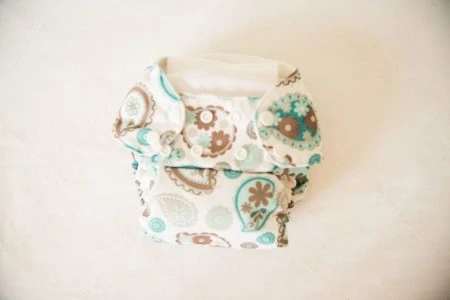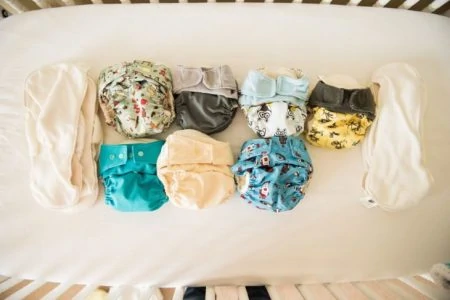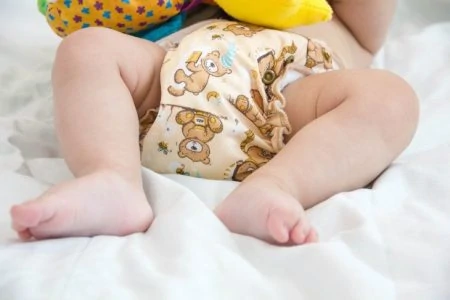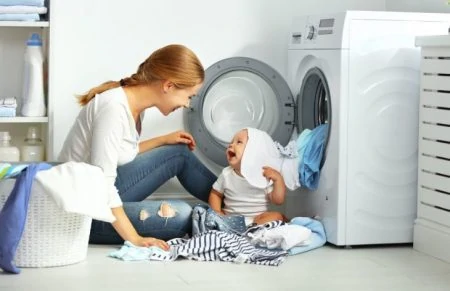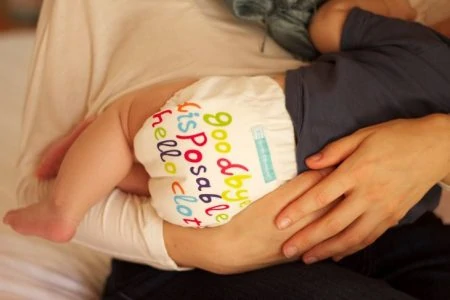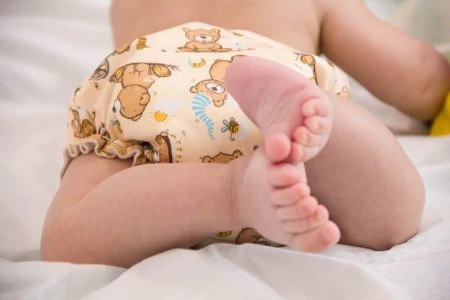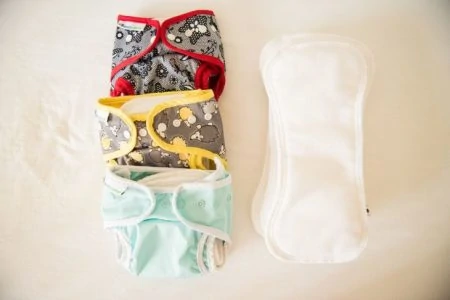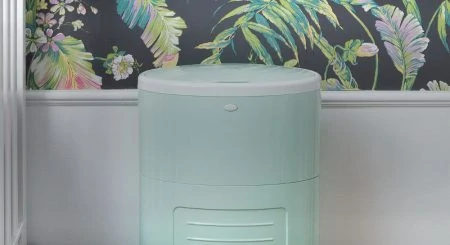Washing cloth diapers feels like a huge hurdle for new parents. We often assume it requires boiling water, weird chemicals, or magic spells.
The reality is much simpler. If you can do a load of towels, you can wash cloth diapers.
We have used cloth diapers for years and saved thousands of dollars doing so. Once you establish a simple routine, the laundry becomes just another part of your weekly schedule.
This guide covers the best wash routines, detergent choices, and troubleshooting tips to keep your diapers fresh and absorbent.
Key Takeaways
- Remove solid waste (poop) into the toilet before storing diapers in a dry pail; breastfed poop is the exception.
- Follow a two-cycle routine: a cool pre-wash to loosen soil followed by a hot main wash with heavy agitation.
- Use strong commercial detergents like Tide or Persil rather than homemade mixtures to prevent buildup.
- Test your water hardness; hard water requires added softeners to prevent mineral buildup and odors.
How Do I Empty the Diapers?
Handling the waste is the biggest mental block for parents, but modern tools make it cleaner than you think.
If you exclusively breastfeed your baby, you catch a lucky break. Breast milk poop is water-soluble. You can toss these diapers directly into the pail without rinsing, and your washing machine will handle the rest.
If your baby drinks formula or has started solid foods, you must remove the waste before washing. Leaving solid poop in a diaper pail causes intense odors and bacteria growth.
Here are the best ways to remove solids from a diaper before storage.
- Diaper Sprayer: This is the most popular method. A diaper sprayer attaches to your toilet’s water supply and works like a mini shower head. You spray the waste directly into the bowl. We recommend using a spray shield to prevent splashing the bathroom.
- Disposable Liners: You can place a thin, disposable liner inside the diaper to catch solids. When it is time to change the baby, simply lift the liner out and toss it in the trash. This minimizes the mess significantly.
- Spatula Method: Some parents keep a dedicated “poop spatula” in the bathroom. If the stool is plop-able or sticky, use the spatula to scrape it into the toilet. Sanitize the tool after every use.
- Shake and Plop: As your baby gets older, their stool becomes more solid. Often, you can simply turn the diaper over the toilet, give it a shake, and gravity does the rest.
Storing Dirty Cloth Diapers
Proper storage prevents stink and protects the fabric until wash day.
We recommend using a “dry pail” system. This means you store the dirty diapers in a pail or wet bag without any standing water. Soaking dirty diapers in water creates a drowning hazard and breeds bacteria that can destroy the elastic and waterproofing.
1. Open vs. Closed Pails
Airflow is your friend. While it seems counterintuitive, an open pail (like a laundry basket with holes) often smells less than a sealed can.
When you seal dirty diapers in an airtight container, the urine breaks down into ammonia. This creates a burning “barnyard” stench that is hard to wash out. An open pail allows airflow, which dries the diapers out and reduces ammonia formation.
2. Wet Bags
Use a waterproof bag, known as a wet bag, to line your pail. We suggest buying two large pail liners. When one is in the wash with the diapers, you can immediately line the pail with the spare.
Travel Storage
How Often Should I Wash?
Aim to wash your cloth diapers every two to three days.
Waiting longer than three days allows stains to set and bacteria to multiply. This makes the cleaning process much harder. Conversely, washing every single day adds unnecessary wear and tear to your fabrics (and your sanity).
The Golden Rule: The Two-Cycle Wash
Regardless of your machine type, the secret to clean cloth diapers is using two distinct wash cycles. One cycle is rarely enough to remove all the urine and waste.
1. Cycle One: The Pre-Wash
The goal of the first cycle is to remove the bulk of the “gunk.”
Set your machine to a quick wash or normal cycle with cool or warm water. Add a small amount of detergent (line 1 on the cup). This cycle flushes out the urine and poop so the diapers are not swimming in dirty water during the main wash.
2. Cycle Two: The Main Wash
The goal of the second cycle is deep cleaning.
Set your machine to a heavy-duty cycle with hot water. Add the full recommended amount of detergent for a heavily soiled load. This long, hot agitation cleans the fibers thoroughly.
Loading The Machine
Choosing the Right Detergent
You do not need expensive, specialty “cloth diaper specific” detergents. In fact, mainstream detergents often work best because they contain strong enzymes that break down human waste.
We recommend avoiding homemade detergents. Most recipes rely on bar soap (like Fels-Naptha), which leaves a waxy residue on fabrics. This residue causes diapers to repel liquid, leading to leaks.
Here are reliable detergent options.
- Powdered Tide: This is the gold standard in the cloth diaper community. It softens water slightly and cleans aggressively.
- Persil: A very strong liquid detergent that works well on tough stains.
- Seventh Generation Ultra Power Plus: A great option if you prefer a plant-based detergent, but ensure you use hot water to activate it properly.
- Kirkland Signature (Costco): An affordable and effective free-and-clear option.
Fabric Softener Warning
Drying Cloth Diapers
You have two main options for drying: the dryer or the clothesline.
1. Machine Drying
Most modern cloth diapers, including those with PUL (waterproof laminate), can go in the dryer on low or medium heat. High heat may degrade the elastics over time.
Pocket diapers and inserts dry quickly. All-in-one diapers, which have thick internal layers, may require a longer cycle.
2. Line Drying
Hanging diapers outside is energy-efficient and extends the life of your elastics.
The sun is also a natural stain remover. If your diapers have yellow shadows from breastfed poop, laying them damp in direct sunlight for a few hours can bleach them sparkling white.
Troubleshooting Common Issues
If your diapers smell bad or stop absorbing, something in the routine is off. Here is how to fix the most common problems.
1. Hard Water Issues
Hard water contains minerals like calcium and magnesium. Over time, these minerals get trapped in the fabric, holding onto bacteria and causing stink.
If you have hard water, your detergent might not be effective enough on its own. You can add a water softener to your main wash cycle. Calgon and Borax are popular boosters that help your detergent rinse clean.
2. Repelling and Leaks
If liquid beads up on the diaper instead of soaking in, you likely have residue buildup. This usually comes from diaper creams or fabric softeners.
To fix this, scrub the inside of the diaper with blue Dawn dish soap and a toothbrush, then rinse thoroughly. Ensure you only use cloth-safe diaper creams (avoid petroleum/zinc combos unless using a liner).
3. Barnyard or Ammonia Smell
Clean diapers should smell like nothing.
If they smell like a barnyard immediately out of the dryer, they are not getting clean. You likely need more detergent or a better agitation cycle.
If they smell like ammonia (strong chemical smell) as soon as the baby pees, you have detergent buildup or trapped bacteria. You may need to “strip” and sanitize your diapers.
4. Stripping vs. Sanitizing
These are two different processes used for deep cleaning.
- Stripping: This removes mineral and detergent buildup. You use a product like RLR or GroVia Mighty Bubbles. It releases the “gunk” trapped in the fibers.
- Sanitizing: This kills bacteria and yeast. You typically use diluted bleach. This is necessary if you buy used diapers or if your baby has a yeast rash.
To sanitize with bleach, add regular liquid bleach (check the bottle date to ensure freshness) to a cold water soak. Soak clean diapers for 30 minutes, then rinse hot.
FAQs
You Got This
Cloth diapering often seems overwhelming until you do your first load. Once you realize it is just a matter of “rinse, wash, dry,” the anxiety disappears.
Find a detergent you like, stick to the two-cycle rule, and enjoy the money you are saving. You are doing a great job for your baby and your wallet.
